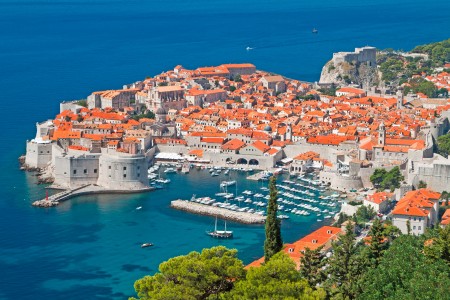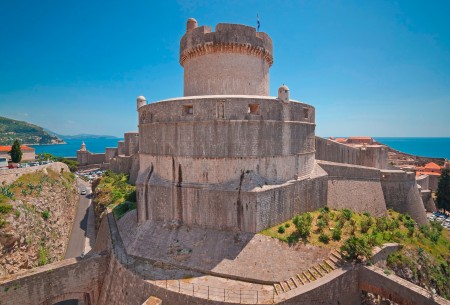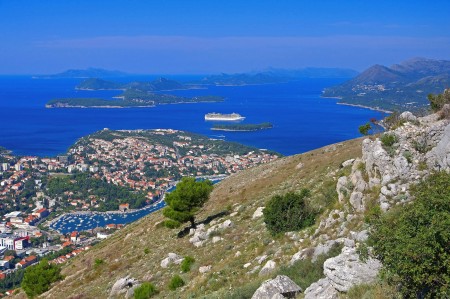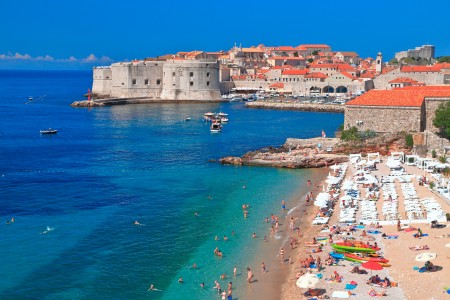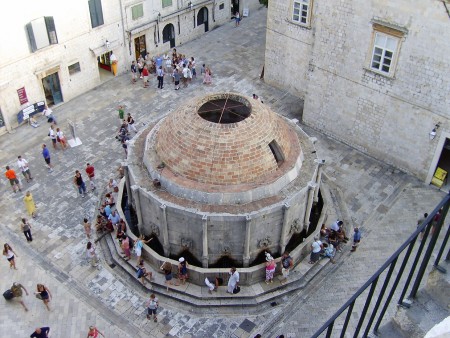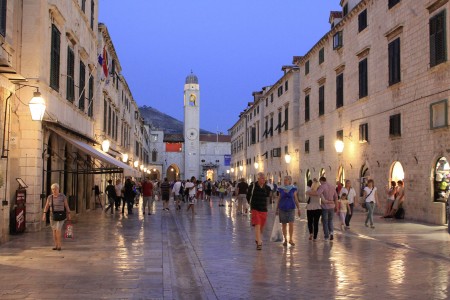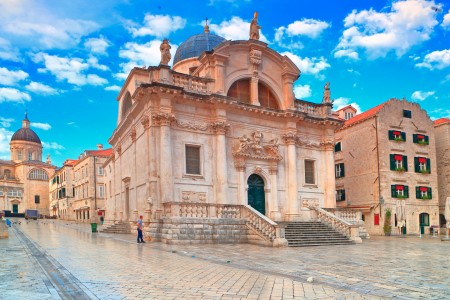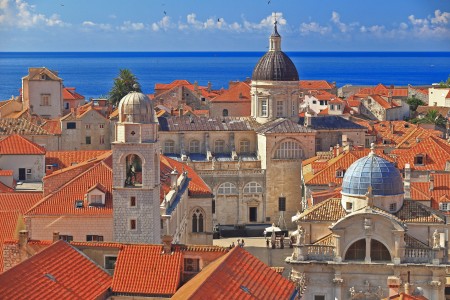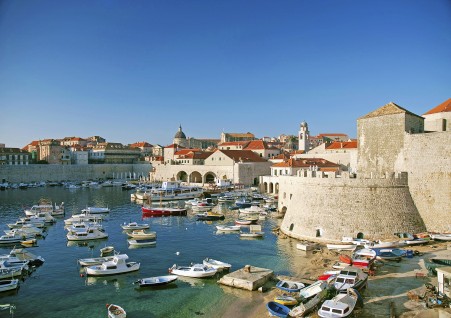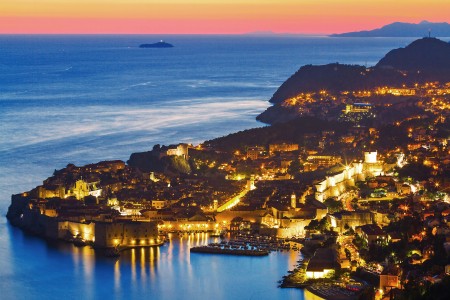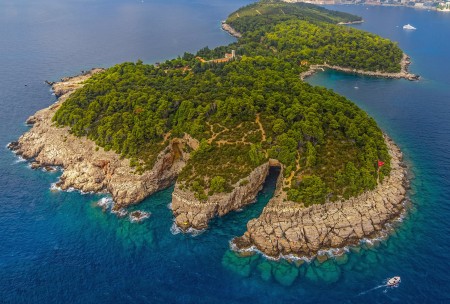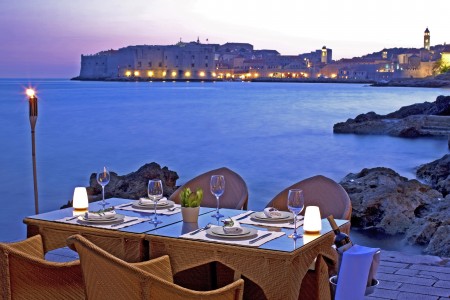Dubrovnik
Accommodation
- ‹
- ›
- ‹
- ›
- ‹
- ›
Hotel Resorts / Mobile Homes
Transport Type:
Property Type
Facilities
Pets
More search options
Reset search options
Description:
General information
The city of Dubrovnik (Ragusa) is known as the "pearl of the Adriatic". In the period of its ancient splendour it has been an important economic and cultural centre of the Mediterranean. Today, the ancient part of the city is free from traffic and is a true open museum, with ancient palaces and cultural attractions. UNESCO took up Dubrovnik, with its historically authentic old part of town, on the World Heritage List. Tradition remains in Dubrovnik also in other ways. International cultural programs extending into the autumn are sufficient for the highest artistic expectations. International festivals of music and folklore groups from Croatia and from all over the world gather here. With 220 sunny days per year, you are invited, above all, to pass pleasant evenings in the beautiful gardens and restaurants. The city, the one-time republic of Dubrovnik (Ragusa), was taken from Venice, the greatest port of the Mediterranean. The ancient city, fortified with its walls, the crystal sea and its natural beauties have made Dubrovnik an extraordinary tourist attraction. Moreover, thanks to its geographic position, it has an optimal Mediterranean climate, with calm and rainy winters and warm and dry summers. On the outskirts of the city, where the nature is still uncontaminated, there are small fishermen’s villages as well as on the Elafiti island, trained in the city. This interface between nature and culture makes Dubrovnik one of the most beautiful and desirable destinations of the Mediterranean. Famous writer Bernard Show, after having visited Dubrovnik, said "He who wants to see paradise must come to Dubrovnik!"
History
Dubrovnik has developed successfully due to a favorable geographic position and economy based on maritime trade. Recent research has shown that first settlement existed already in the 6th century, and with the arrival of Croats in the 7th century the town started to develop parallel with Epidaurus, present day Cavtat. In the 12th and the 13th c. traffic between East and West became stronger. Crusade wars have been favorable for the development of trade centers on the Mediterranean, and Dubrovnik, being one of those centers developed suddenly. In the 14th century Dubrovnik became free from Venetian domination by Zadar certificate, after which it started to develop further and better. The Dubrovnik Republic finally developed in the 16th century. In the year 1667 Dubrovnik experienced a crisis after a large earthquake, but that crisis was only temporary. In 1815 Dubrovnik becomes a part of Croatia and Dalmatia by a decision made in Vienna congress. In the 20th century Dubrovnik suffered attacks during the Civil war in the 1990-ies. Today it has been mostly renovated and it lures guests with its beauty and pride.
Gastronomy
Of course, first thing that comes to mind when we mention the food of Dubrovnik is a typical sweet dish from this area, called rozata. Rozata is a thick cream made of eggs, flour and milk, served cold and covered with caramel syrup.
But Dubrovnik offers you a lot of good and tasty food prepared according to old recipes. Dubrovnik's tables offer a lot of fish in olive oil guaranteeing good health. There are also vegetables, which are usually prepared simply, just cooked in salt water and dressed again with olive oil.
One of the sweet specialties is also sugared lemon and orange peel which go especially well with some liquors.
Allow friendly Dubrovnik residents to recommend you with some of the specialties you can taste in local restaurants which are a pleasure to eat in since you can see from almost every one a beautiful view over the town or romantic blue of the sea.
Fun and Night Life
For those in search of nightlife, there are discotheques where you can dance till dawn and often there are parties organized in the open, and need we explain any more? Warm summer nights, good music, cheerful atmosphere, a glass of good wine.. and that's it!
Gain your lost strength on Stradun with the first morning coffee you can drink while cozily stretched in deep sofas of some of the lounge bars.
If you come to Dubrovnik in winter, especially around Christmas and New Year, find out how these holidays are celebrated in Dubrovnik. We are only going to tell you that they are celebrated with a lot of song and congratulations that echoes around the whole town and all are welcomed to this noble festivity.
Last but not least, Dubrovnik has its famous Dubrovnik Summer Games, a theater festival that attracts culture lovers every year. You are also welcome to visit numerous exhibitions in small galleries, churches, palaces, and classical music concerts which are held almost every night.
Beaches
Many tourist magazines referred to the beach under the city walls as one of the most beautiful beaches in Europe. Swimming and enjoying the view of the walls, which are a spectacular trace of ancient times, is truly a unique experience. The beach itself is a pebble beach with a terrace where one can enjoy a refreshing beverage. Near Dubrovnik, the beaches are mainly rocky, while the hotel beaches are mainly concrete terraces. An excursion to Lokrum is also a unique opportunity – swimming in a lake situated in the middle of an island and you can swim to a small cave. On the island of Lopud, one of the Elaphite islands, is a long sandy beach known as Sunj and getting to the beach is quite an adventurous walk. However, once you have reached the beach, you will see that it was well worth it.
Sightseeing:
The walls
Dubrovnik city walls represent a bond between the present and the past and serve as one of the best protection systems in Europe. Together with five defensive towers they are 1940 meter in length, and is a must-see. Walk on the walls that surround the Old town, enjoy the view over roof tops, sea and Lokrum and you will soon feel like a time traveler. Various events and concerts are held in the towers even today, and Minceta tower is often a place for weddings.
Sponza palace
The state archive is kept in Sponza palace, together with documents from the 12th c. There you can see how Dubrovnik developed its political, trading and economic relations with the rest of Europe since it was an independent republic.
Lovrijenac
This monumental and impressive fortress outside the city wall from where the main entrance to the city was guarded was witness to the origin of the city and of the heroic feats of its guards and defenders. Today it is quite picturesque during the Dubrovnik Summer Games, and “Hamlet” is one of the traditional performances held every season.
Orlando's column
Near Vrata od Ploca there is a column with a figure of Orlando, a hero from the Middle Ages, who is a supposed nephew of Carl the Great. Orlando's column was raised in Dubrovnik in the 15th century as a symbol of freedom and state independence. Even today during the Dubrovnik summer games, flag with an inscription Libertas (freedom) is placed on this column. Today, Orlando's column is a place of gathering of Dubrovnik residents. It is usual to set a date near the column and go further from there. You can do this as well!
The city of Dubrovnik (Ragusa) is known as the "pearl of the Adriatic". In the period of its ancient splendour it has been an important economic and cultural centre of the Mediterranean. Today, the ancient part of the city is free from traffic and is a true open museum, with ancient palaces and cultural attractions. UNESCO took up Dubrovnik, with its historically authentic old part of town, on the World Heritage List. Tradition remains in Dubrovnik also in other ways. International cultural programs extending into the autumn are sufficient for the highest artistic expectations. International festivals of music and folklore groups from Croatia and from all over the world gather here. With 220 sunny days per year, you are invited, above all, to pass pleasant evenings in the beautiful gardens and restaurants. The city, the one-time republic of Dubrovnik (Ragusa), was taken from Venice, the greatest port of the Mediterranean. The ancient city, fortified with its walls, the crystal sea and its natural beauties have made Dubrovnik an extraordinary tourist attraction. Moreover, thanks to its geographic position, it has an optimal Mediterranean climate, with calm and rainy winters and warm and dry summers. On the outskirts of the city, where the nature is still uncontaminated, there are small fishermen’s villages as well as on the Elafiti island, trained in the city. This interface between nature and culture makes Dubrovnik one of the most beautiful and desirable destinations of the Mediterranean. Famous writer Bernard Show, after having visited Dubrovnik, said "He who wants to see paradise must come to Dubrovnik!"
History
Dubrovnik has developed successfully due to a favorable geographic position and economy based on maritime trade. Recent research has shown that first settlement existed already in the 6th century, and with the arrival of Croats in the 7th century the town started to develop parallel with Epidaurus, present day Cavtat. In the 12th and the 13th c. traffic between East and West became stronger. Crusade wars have been favorable for the development of trade centers on the Mediterranean, and Dubrovnik, being one of those centers developed suddenly. In the 14th century Dubrovnik became free from Venetian domination by Zadar certificate, after which it started to develop further and better. The Dubrovnik Republic finally developed in the 16th century. In the year 1667 Dubrovnik experienced a crisis after a large earthquake, but that crisis was only temporary. In 1815 Dubrovnik becomes a part of Croatia and Dalmatia by a decision made in Vienna congress. In the 20th century Dubrovnik suffered attacks during the Civil war in the 1990-ies. Today it has been mostly renovated and it lures guests with its beauty and pride.
Gastronomy
Of course, first thing that comes to mind when we mention the food of Dubrovnik is a typical sweet dish from this area, called rozata. Rozata is a thick cream made of eggs, flour and milk, served cold and covered with caramel syrup.
But Dubrovnik offers you a lot of good and tasty food prepared according to old recipes. Dubrovnik's tables offer a lot of fish in olive oil guaranteeing good health. There are also vegetables, which are usually prepared simply, just cooked in salt water and dressed again with olive oil.
One of the sweet specialties is also sugared lemon and orange peel which go especially well with some liquors.
Allow friendly Dubrovnik residents to recommend you with some of the specialties you can taste in local restaurants which are a pleasure to eat in since you can see from almost every one a beautiful view over the town or romantic blue of the sea.
Fun and Night Life
For those in search of nightlife, there are discotheques where you can dance till dawn and often there are parties organized in the open, and need we explain any more? Warm summer nights, good music, cheerful atmosphere, a glass of good wine.. and that's it!
Gain your lost strength on Stradun with the first morning coffee you can drink while cozily stretched in deep sofas of some of the lounge bars.
If you come to Dubrovnik in winter, especially around Christmas and New Year, find out how these holidays are celebrated in Dubrovnik. We are only going to tell you that they are celebrated with a lot of song and congratulations that echoes around the whole town and all are welcomed to this noble festivity.
Last but not least, Dubrovnik has its famous Dubrovnik Summer Games, a theater festival that attracts culture lovers every year. You are also welcome to visit numerous exhibitions in small galleries, churches, palaces, and classical music concerts which are held almost every night.
Beaches
Many tourist magazines referred to the beach under the city walls as one of the most beautiful beaches in Europe. Swimming and enjoying the view of the walls, which are a spectacular trace of ancient times, is truly a unique experience. The beach itself is a pebble beach with a terrace where one can enjoy a refreshing beverage. Near Dubrovnik, the beaches are mainly rocky, while the hotel beaches are mainly concrete terraces. An excursion to Lokrum is also a unique opportunity – swimming in a lake situated in the middle of an island and you can swim to a small cave. On the island of Lopud, one of the Elaphite islands, is a long sandy beach known as Sunj and getting to the beach is quite an adventurous walk. However, once you have reached the beach, you will see that it was well worth it.
Sightseeing:
The walls
Dubrovnik city walls represent a bond between the present and the past and serve as one of the best protection systems in Europe. Together with five defensive towers they are 1940 meter in length, and is a must-see. Walk on the walls that surround the Old town, enjoy the view over roof tops, sea and Lokrum and you will soon feel like a time traveler. Various events and concerts are held in the towers even today, and Minceta tower is often a place for weddings.
Sponza palace
The state archive is kept in Sponza palace, together with documents from the 12th c. There you can see how Dubrovnik developed its political, trading and economic relations with the rest of Europe since it was an independent republic.
Lovrijenac
This monumental and impressive fortress outside the city wall from where the main entrance to the city was guarded was witness to the origin of the city and of the heroic feats of its guards and defenders. Today it is quite picturesque during the Dubrovnik Summer Games, and “Hamlet” is one of the traditional performances held every season.
Orlando's column
Near Vrata od Ploca there is a column with a figure of Orlando, a hero from the Middle Ages, who is a supposed nephew of Carl the Great. Orlando's column was raised in Dubrovnik in the 15th century as a symbol of freedom and state independence. Even today during the Dubrovnik summer games, flag with an inscription Libertas (freedom) is placed on this column. Today, Orlando's column is a place of gathering of Dubrovnik residents. It is usual to set a date near the column and go further from there. You can do this as well!
Location
Click here to activate Google Maps
If you activate Google Maps, your browser will fetch the map data directly from Google servers in the USA and display it here.



